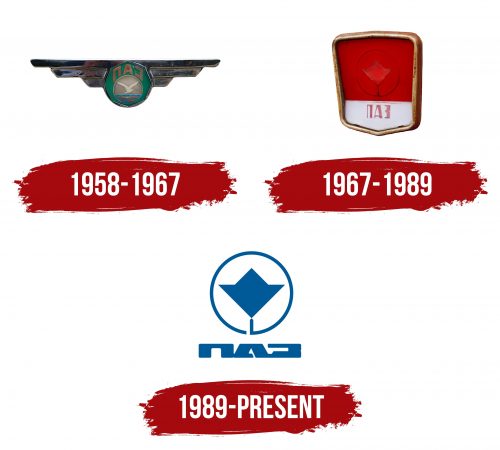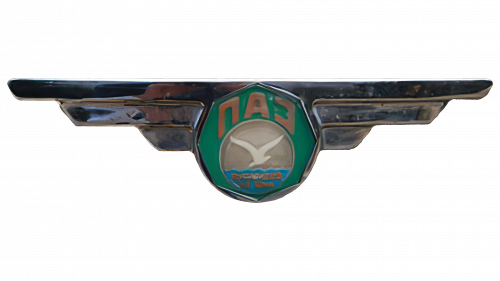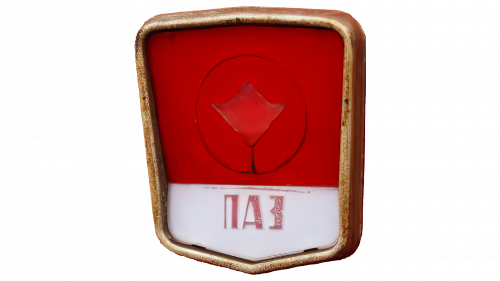The PAZ logo was intended to convey the bus manufacturer’s reliability and simplicity. However, the emblem’s outdated design lacks originality and does not reflect the company’s values, making it difficult to stand out among competitors.
PAZ: Brand overview
The story of this bus factory, known for its reliable and iconic buses, begins in 1932 in Pavlovo, Russia, as a branch of the Gorky Automobile Plant (GAZ). This factory was set up to address the growing transportation needs of the Soviet Union.
In 1952, the brand produced its first bus, the PAZ-651, based on the GAZ-51 truck chassis, marking the start of a new era in Soviet public transportation. Six years later, in 1958, the factory introduced the PAZ-652, a model that became a staple in their production lineup for many years.
The legendary PAZ-672 debuted in 1968. This model would become the most widely produced bus in the USSR, known for its durability and versatility. The brand’s success was recognized in 1975 when the plant received the Order of the Red Banner of Labor for its achievements in manufacturing.
By 1982, the brand had rolled out its 500,000th bus, highlighting its growing prominence in the Soviet automotive industry. In 1989, the factory began producing the PAZ-3205, the base for numerous subsequent modifications and upgrades.
Transitioning into the post-Soviet era, the brand became a joint-stock company in 1994, adapting to the new economic landscape. The year 2000 marked a significant milestone as the brand celebrated the production of its millionth bus, underscoring decades of success and innovation.
In 2003, the brand joined the “GAZ Group,” enhancing its capacity for development and production. Three years later, in 2006, the factory started producing the PAZ-3237, a medium-class city bus designed to meet urban transportation needs.
Continuing its tradition of innovation, the brand introduced the PAZ-3204 in 2010, designed for both urban and suburban routes. The “Vector” family of buses was unveiled in 2014, showcasing modern design and improved functionality.
In 2016, the brand began serial production of the PAZ-320405-04 “Vector NEXT,” a bus combining advanced technology and reliability. This commitment to innovation was further demonstrated in 2018 with the release of the PAZ-3265-03 electric bus, based on the “Vector NEXT” model.
Meaning and History
What is PAZ?
This is a well-known Russian manufacturer of buses and commercial vehicles. The company specializes in creating various buses that are widely used in Russia and neighboring countries, including city, intercity, and school buses. The brand’s vehicles are known for their durability, reliability, and ability to operate in varied and challenging environments.
1958 – 1967
The old PAZ logo looked unappealing and thus perfectly matched the appearance of the buses it represented. The metal badge, with wings formed from primitive rectangular feathers, might have symbolized speed, but its bulky design makes it appear too heavy. It lacks the lightness associated with swift movement, a significant shortcoming for a vehicle manufacturer.
At the center is a turquoise octagon, visually weighing the emblem down. Its color is somber and contrasts with the shiny metal texture. The numerous angles negatively affect the emotional perception of the logo, subconsciously causing discomfort.
The octagon serves as a base for the Cyrillic inscription “ПАЗ,” an abbreviation of the full company name: Pavlovsky Avtobusny Zavod (Pavlovo Bus Factory). The word consists of indistinct letters, reducing the brand’s recognizability. The letters are arranged in an arch shape, with a gray circle below them with a white bird (presumably a seagull) and blue waves. The designers combined several flight symbols in the emblem, making it more suitable for an airline than a bus manufacturer.
1967 – 1989
The new PAZ logo looks aggressive, dominated by a blood-red color. It has a matte texture with an uneven gradient that creates shadows on the flat surface. The artists depicted the brand’s main symbol, resembling a flower formed by two triangles of different sizes. This abstract design is placed inside a circle and connected to its outline by a short vertical line.
The company does not disclose the meaning of its emblem. Most likely, the four-pointed figure has no hidden significance; it is used solely as a decorative element and is unrelated to the automotive industry. Some see it as a stylized crown, but calling PAZ buses luxurious would be a great exaggeration. If it is indeed a crown, the brand shows its excessive ambitions, which do not match reality.
The logo is shaped like a quadrangular shield with a pointed base. It is surrounded by a wide bronze frame, making it bulky. Only the upper part of the shield is painted red, while the bottom uses white to contrast with the red. However, due to its grayish tint, it does not evoke associations with purity and lightness. Additionally, it is further weighed down by the Cyrillic inscription “ПАЗ,” written in a contrasting font with unevenly thickened letters.
1989 – today
After the rebranding, the company continued to use an abstract geometric symbol consisting of two stacked triangles. Whether a flower or a crown, it still lacks meaning and does not indicate that PAZ produces passenger buses.
The quadrangular figure is now colored blue and outlined with a blue ring surrounded by white space. The ring could symbolize infinity, durability, balance, and reliability, but its small gap breaks its continuity. Since the circular shape is associated with a wheel, it should not have any gaps.
Due to the crude font, the “ПАЗ” inscription has become nearly illegible. The last letter does not resemble the Cyrillic “З” at all, the “А” lacks its entire lower half, and only the “П” remains recognizable, allowing for an approximate identification of the brand name. The squished, bold glyphs are very close together, merging at the sides to form a continuous jagged line. This font might be intended to convey the heaviness of PAZ buses.







